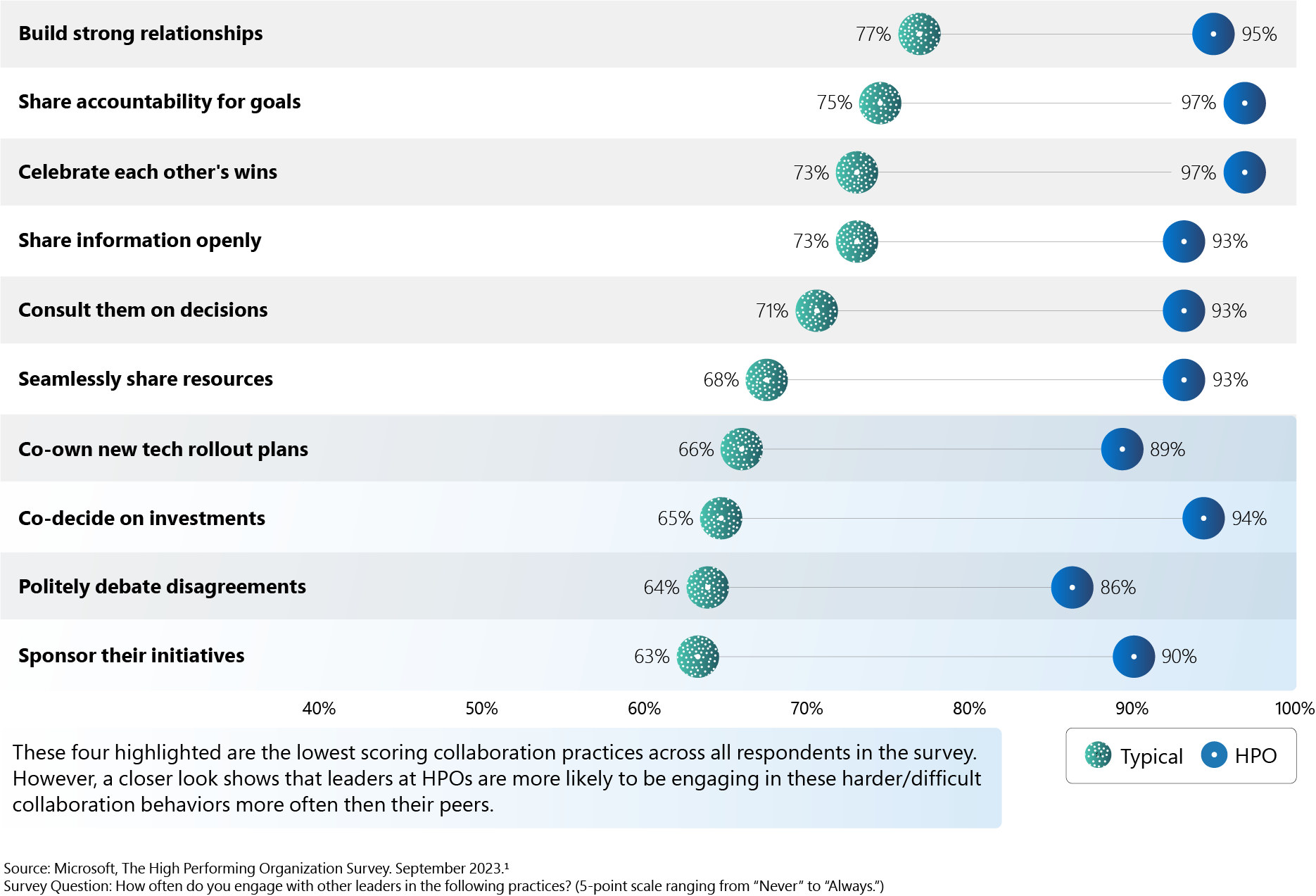Leaders today understand the importance of working together. And yet, our analysis of the HPO survey found that when leaders collaborate with other leaders, they’re most often engaging in positive, low-conflict connections, like building strong relationships (80%) and celebrating each other’s wins (77%). It’s likely no coincidence that the most frequent types of collaboration are friendly and congratulatory in nature, the sort of thing everyone likes to share.
However, the types of collaboration that leaders tend to engage in less often are the more difficult ones, centered around issues of money, navigating conflict, and taking on additional work. Rounding out the bottom of the list of collaboration practices are co-deciding on investments (69%), sponsoring one another’s initiatives (67%), and politely debating disagreements (67%).
These trickier types of collaboration, however, can be more impactful on organizational performance, particularly when it comes to aligning on strategic priorities, creating a shared vision for the organization, and deciding where to invest to improve performance outcomes.
Better Together
Leaders at HPOs don’t shy away from the difficult—but impactful—types of collaboration that many leaders avoid.


HPO leaders know this. The 15 percent of leaders whose organizations are HPOs by our definition said they invest more time than their peers in all types of collaboration, and they’re significantly more likely to engage in the more complex and challenging ways of working together. Ninety-four percent of these HPO leaders say they often or always co-decide on investments, compared to just 65 percent of leaders at typical organizations. Eighty-six percent of HPO leaders say they politely debate disagreements, while just 64 percent of their peers do so, and 90 percent of HPO leaders say they often or always sponsor others’ initiatives—whereas only 63 percent of leaders do at typical organizations.
Across departments, leaders in our survey planned to prioritize several of the same key areas in the coming year: They intend to improve performance expectations, create better internal communications and leadership visibility, and understand worker skills in order to facilitate skill development and opportunities for talent mobility. These areas of alignment are good places for leaders to begin working together across departments to make investment decisions and co-sponsor initiatives.
HR, IT, and the Digital Transformation Connection
The capabilities associated with being an HPO are largely related to human factors. And yet technology, particularly AI, is key to supporting and enabling those human factors. That means that close collaboration between IT and HR teams is necessary to reach HPO goals.
“A really key success factor I’ve found is the partnership between the CIO and the CHRO to create alignment between the world of technology and the world of people,” Patton says. This is especially true when it comes to co-deciding on investments—an area of collaboration that leaders struggle with.
When it comes to making decisions on technology investments, most IT leaders in our survey said they most frequently collaborated with their own teams (88%), and just 29 percent said they work closely with HR to make investment decisions.
Similarly, HR leaders said their own teams were their most frequent collaborators (78%), and just 47 percent said they work with IT to make decisions about technology investments.
“HR and IT have made great progress working together, especially on technology decisions,” Khatri says. “But reaching this new performance state will require even deeper collaboration between leaders, not only on vision, but also change management and using data-driven insights to continuously work toward improving engagement and performance.”
Interestingly, both IT and HR leaders said they frequently collaborate with Digital Transformation or Digital Experience leaders to decide on technology investments—in both cases, the Digital Transformation leader was the second most frequent collaborator, after IT and HR leaders’ own teams.
Digital Experience and Digital Transformation leaders are relatively new roles that focus on aligning technologies with human-centered needs and values. As such, they act as the glue between IT and HR, serving as both mediator and translator. “HR program owners know HR in such depth and detail, but they may get lost if the IT person starts talking tech speak,” says Prerna Ajmera, General Manager, HR Digital Strategy and Innovation at Microsoft. On the IT side, Ajmera says, teams may work hard to deliver a specific product, only to find out that it did not account for human factors that could affect its success.
Serving as a bridge between IT and HR, Digital Experience leaders can draw from the strengths of both groups to deliver the employee experiences that are associated with high performance.
Performance Is about More than Profits
The new performance dashboard shows that financial success isn’t the whole story.
Sweat the Hard Stuff
The most important drivers of high performance are also the hardest to master.
Use AI as an Accelerant
AI can help organizations leapfrog the barriers that slow progress toward HPO goals.
